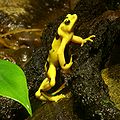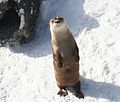Buffalo Zoo
| Buffalo Zoo | |
|---|---|
 | |
 | |
| Date opened | 1875 |
| Location | 300 Parkside Ave, Buffalo, New York, United States |
| Land area | 23.5 acres (9.5 ha) |
| No. of animals | 1200 |
| Annual visitors | 400,000 |
| Memberships | AZA[1] |
| Major exhibits | Arctic Edge, Rainforest Falls, Sea Lion Cove, Otter Creek, Vanishing Animals, Rhino Yards, Giraffes, Kookaburra Corner, EcoStation, Heritage Farm (Children's Zoo) |
| Public transit access | |
| Website | www |
Buffalo Zoo Entrance Court | |
 Buffalo Zoo Entrance Court, April 2013 | |
| Location | 300 Parkside Ave. Buffalo, New York |
| Coordinates | 42°56′21″N 78°51′13″W / 42.9391°N 78.8536°W |
| Area | less than one acre |
| Built | 1935-1938 |
| Architect | Brent, John Edmonston |
| NRHP reference No. | 13000305[2] |
| Added to NRHP | May 22, 2013 |
Founded in 1875, the Buffalo Zoo, located at 300 Parkside Ave in Buffalo, New York, is the seventh oldest zoo in the United States. Each year, the Buffalo Zoo welcomes approximately 400,000 visitors and is the second largest tourist attraction in Western New York; second only to Niagara Falls.[citation needed] Located on 23.5 acres (9.5 ha) of Buffalo's Delaware Park, the zoo exhibits a diverse collection of wild and exotic animals, and more than 320 different species of plants. The zoo is open year-round.
History

The zoo traces its history to the mid-19th century when Jacob E. Bergtold, a Buffalo furrier, presented a pair of deer to the city of Buffalo. To provide the deer with room to graze, Elam R. Jewett, the publisher of the Buffalo Daily Journal, offered to house the deer on his estate. Simultaneously, plans were being made for the municipal North Park (today's Delaware Park), and Mayor William F. Rogers hired landscape architect, Frederick Law Olmsted, to include a zoo as part of the park's design. Five years after, the deer were donated, more animals were added to the collection, and the first permanent building was erected in 1875, officially establishing the Buffalo Zoological Gardens.[3]
The zoo underwent a large expansion during the Great Depression and became a major work site for the Works Progress Administration. Among the new structures was the Buffalo Zoo Entrance Court at Parkside Avenue and Amherst Street. It was designed by African-American architect John Edmonston Brent (son of architect Calvin Brent[4]) and built 1935–1938.[5] The Buffalo Zoo Entrance Court was listed on the National Register of Historic Places in 2013.[2]
Throughout the next several decades, more exhibits and facilities were added, including the Reptile House (1942), Children's Zoo (1965), Giraffe House and Veterinary Hospital (1967), and The Gorilla Habitat Building (1981). The zoo's mission also began to change during the 1980s and 1990s under the direction of Minot Ortolani, as it began reducing the numbers of animals in its collection to focus on the breeding of endangered species that might not otherwise have a chance at survival. In addition to its conservation efforts, the zoo also placed more of an emphasis on education to teach visitors about the animals and their natural habitats.[citation needed] From 2000 - 2017 the President/CEO of the zoo was Dr Donna M. Fernandes, with Norah B. Fletchall succeeding her in 2017.[6]
In 2002, a 15-year master plan was unveiled to transform the zoo. New visitor amenities and naturalistic habitats were planned, including the Asian River and Highlands Zone, African Watering Hole, Arctic Edge, and the Wonders of Water Children's Zoo. Phase One of the Master Plan has resulted in the opening of the Vanishing Animals exhibit, EcoStation, Otter Creek, and Sea Lion Cove. The completion of Phase One was marked by the September 10, 2008, opening of the South American Rainforest, a four-season attraction that features a two-story waterfall, dozens of colorful birds, and a variety of other rainforest species.[7] In the fall of 2015 the $14 million Arctic Edge opened to the public featuring Arctic wolves, lynxes and polar bears. In 2016 the Arctic wolves were replaced by Arctic foxes which fit the size of the exhibit better than the wolves. Arctic Edge is currently home to two polar bears Anana and Luna. Luna is the offspring of Anana and Nanuq, who now resides at the Columbus Zoo.
In March 2018, the zoo's Reptile House was closed for 14 months to undergo a $3.7 million remodel.[8] It reopened on May 24, 2019, as the Donna M. Fernandes Amphibian and Reptile Center with a new roof, refreshed exhibits, interactive graphics and a conservation room.[9]
In August 2018, the zoo announced it would be sending its two Asian elephants, Jothi and Surapa to the Audubon Zoo in New Orleans due to being unable to care for them anymore.[10] They arrived at the Audubon Zoo later that year. As of 2022, the former elephant habitat is currently occupied by black rhinos.[11]
In early June 2020, a red-footed tortoise was reportedly stolen from the zoo. There was an ongoing police search, but the tortoise, 'Red', was never found.[12]
Animals
- Mammals
- Birds
- Reptiles
- Amphibians
- Anderson's crocodile newt
- Axolotl
- Cane toad
- Dyeing poison frog
- Green and black poison dart frog
- Hellbender
- Mission golden-eyed tree frog
- Panamanian golden frog
- Puerto Rican crested toad
- Solomon Islands leaf frog
- Yellow-banded poison dart frog
- Fish
- Cichlids
- Common pleco
- Magdalena River stingray
- Ocellate river stingray
- Silver dollar fish
- Spotted Rafael catfish
- Invertebrates
Gallery
- Siberian tiger cubs playing in the snow at the Buffalo Zoo.
- A spectacled bear at the Buffalo Zoo.
- Two-toed sloth hanging from a tree at the Buffalo Zoo.
- Long-tailed river stingray at the Buffalo Zoo.
- A Panamanian golden frog in its habitat at the Buffalo Zoo.
- One of the Buffalo Zoo's princess parrots.
- Northern river otter playing in the snow at the Buffalo Zoo.
- One of the Buffalo Zoo's Indian rhinoceroses.
- A sleeping snow leopard at the Buffalo Zoo.
- One of the Buffalo Zoo's Brazilian agoutis.
- Desert iguanas in their habitat at the Buffalo Zoo.
- A polar bear roaming his habitat at the Buffalo Zoo.
- A juvenile Sulawesi crested macaque at the Buffalo Zoo.
- A lion sleeping against the protective glass at the Buffalo Zoo.
References
- ^ "Currently Accredited Zoos and Aquariums". aza.org. AZA. Retrieved February 19, 2011.
- ^ a b "National Register of Historic Places Listings". Weekly List of Actions Taken on Properties: 5/20/13 through 5/24/13. National Park Service. May 31, 2013.
- ^ "A Zoo with a Long History". Buffalo Zoo. Retrieved April 12, 2023.
- ^ "John Edmonston Brent". www.BurchfieldPenney.org. Buffalo State University, NY. Retrieved January 7, 2019.
- ^ "Project: Buffalo Zoo Entrance Court, 13PR05772". Cultural Resource Information System (CRIS). New York State Office of Parks, Recreation and Historic Preservation. Archived from the original (Searchable database) on April 4, 2019. Retrieved July 1, 2016. Note: This entry includes National Register of Historic Places Registration Form: Buffalo Zoo Entrance Court and Accompanying 13 photographs
- ^ Sommer, Mark (April 24, 2017). "Indianapolis zoo official to succeed Fernandes in Buffalo". The Buffalo News. Retrieved May 22, 2017.
- ^ Heap, Mildred F. (1982). The Buffalo Zoo Story. Buffalo Zoological Gardens.
- ^ "Buffalo Zoo Announces Launch of Reptile House Renovation". Buffalo Zoo. March 23, 2018. Retrieved July 24, 2022.
- ^ "The All-New Donna M. Fernandes Amphibian and Reptile Center At the Buffalo Zoo Ready to Open". Buffalo Zoo. May 23, 2019. Retrieved July 24, 2022.
- ^ "The Buffalo Zoo Announces Elephants Relocating to Audubon Zoo". Buffalo Zoo. August 14, 2018. Retrieved July 24, 2022.
- ^ Sommer, Mark (August 19, 2020). "Buffalo Zoo welcomes return of black rhinoceros". The Buffalo News. Retrieved July 24, 2022.
- ^ Culver, Jordan. "Where's 'Red'? New York police are investigating theft of a red-footed tortoise from the Buffalo Zoo". USA TODAY. Retrieved February 1, 2021.


















